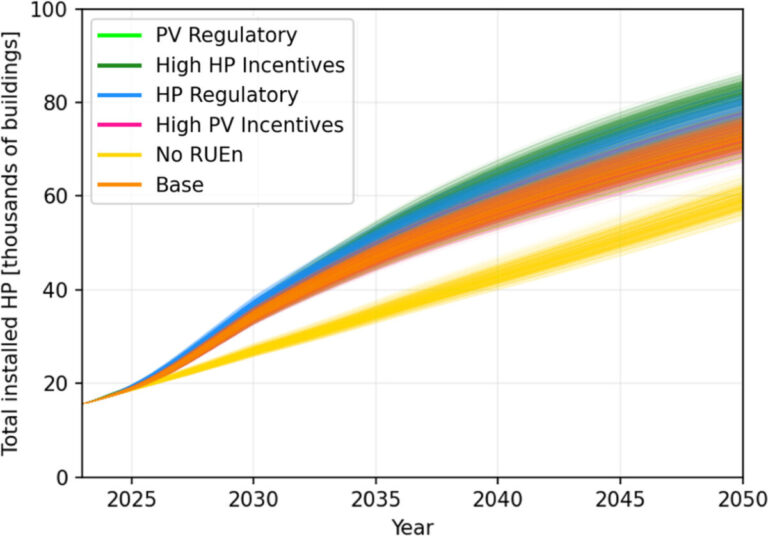Scientists in Switzerland have created a system dynamics model for the adoption of PV and heat pumps in Swiss residential buildings until 2050. They examined different scenarios to see how the incentive for PV influences the adoption of heat pumps and vice versa. have concluded that strong regulatory changes are needed to fully decarbonize the housing sector.
A research group led by ETH Zurich has modeled the co-adoption dynamics of PV and heat pumps (HPs) in Swiss residential buildings. A case study was used for the Swiss canton of Ticino, which includes cities such as Lugano and Bellinzona, with the simulation running until 2050 under different regulatory scenarios.
“This study presents a system dynamics (SD) model that evaluates the co-adoption process of PV and heating (HV) solutions in the Swiss residential sector. The model takes into account the interdependence of these decisions, as the evaluation of installing a PV also includes the consideration of HV, and vice versa,” the academics said. “SD was chosen because it is known as a modeling approach for strategy development and better decision-making in complex systems.”
SD divides a system into several variables, and the relationships between these variables are mapped via a causal loop diagram (CLD). Overall, the researchers used three pillars in the model – namely electricity price, electricity adoption and solar energy adoption – all of which influence each other. It includes reinforcement loops (R) that amplify changes, and balancing loops (B) that seek system stability.
Loops R1 and R2 show reinforcing mechanisms driven by peer effects. “Balancing loops B1 and B2 take into account the fixed total number of buildings that can use PV or HP. The reinforcing loops R3 and R4 represent two facets of the same phenomenon and show how the proliferation of electricity-based technologies affects electricity prices,” the team explained.
R5 and B3 outline another consequence of the adoption of PV and HP on the electricity grid, where the integration of these technologies increases the volatility of electricity demand and leads to the need for grid reinforcement by the grid operator. “The cost of upgrading the grid causes higher electricity prices for end users, driving PV (R5) adoption and offsetting HP (B3) adoption. Finally, reinforcing loop R6 represents the techno-economic synergy between PV and HP. Installing an HP in a building increases the economic appeal of installing a PV system, compared to buildings heated by non-electricity-driven technologies,” the academics said.
The simulation was fed with three official databases: one on electricity production installations, the second on the suitability of roofs for solar energy, and the last was a register of buildings and homes. Historical data from the Canton of Ticino were used to further calibrate 49 parameters of the model. A total of six regulatory scenarios were simulated.
The “base case” includes the prevailing incentives and regulatory framework, including the newly introduced RUEn regulations, which came into effect this year. These provisions regulate the installation of new heating systems, limiting the share of energy provided by carbon-emitting technologies to 80% for new buildings and to 90% in the case of replacing heating in an existing building.
Another scenario tested was ‘no RUEn’, a hypothetical case where none of the above actions are taken. In addition, the team tested a scenario where there is an even higher incentive for PV installation, another case where the incentive for HP is higher than RUEn, a case where regulations force more PV installations, and, finally, a scenario in which which more HP installation is enforced.
Image: ETH Zurich, Energy Strategy Reviews, CC BY 4.0
“While the adoption of HP in buildings would have increased even without the RUEn regulations, the base scenario predicts a significantly higher deployment of HP: the share of buildings with an HP in 2050 shifts from 54% in buildings without RUEn scenario to 68% % in the base case,” the scientists said. “Total installed PV capacity is expected to grow significantly in all scenarios considered. As expected, the two scenarios with higher results are the High PV Incentives and the PV Regulatory, where the installed PV capacity reaches 500 MWp.”
Concluding their paper, the team said that “the results show that minor adjustments to the current policy and regulatory framework could allow PV system deployment targets to be achieved safely, but strong adjustments are needed to to fully decarbonise the residential sector.”
The results are presented in “Modeling the co-adoption dynamics of PV and heat pumps in Swiss residential buildings: implications for policy and sustainability objectives”, published in Energy strategy reviews. Scientists from Switzerland’s ETH Zurich and the University of Applied Sciences and Arts of Southern Switzerland conducted the research.
This content is copyrighted and may not be reused. If you would like to collaborate with us and reuse some of our content, please contact: editors@pv-magazine.com.
Popular content



